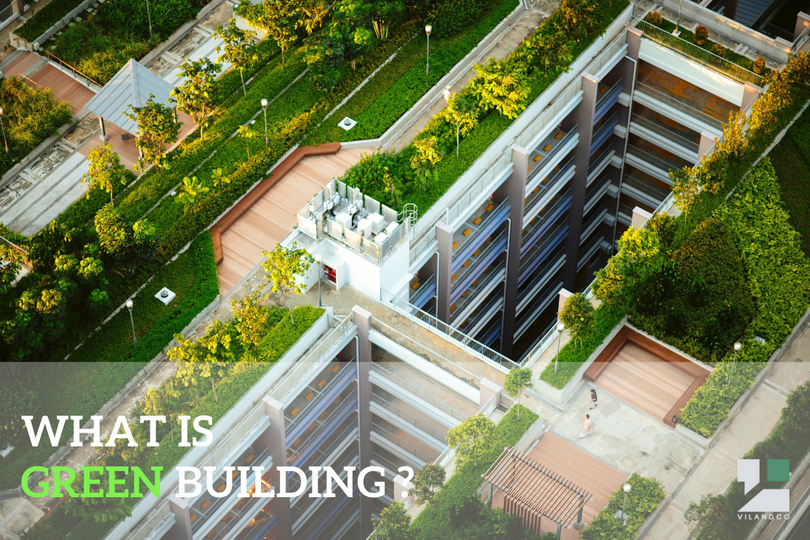Origin of “Green Building”
Currently, the phrase “Green Building” (GB) has appeared for a while and is gradually becoming more popular in Vietnam, however, the quantity variance between Green Building and Normal Building is still very large. There are many reasons that hinder the development of GB, and one of them is the majority of people’s awareness is not correct about the nature of GB. VILANDCO would like to share with you some information as follows:
Green Building has recently become a revolution of the construction industry, in line withThe Sustainable Development Goals (SDGs), also known as the Global Goals. Since the beginning of the 21st century, when issues related to the environment and climate change have been gradually concerned, the construction has shown higher responsibilities to the natural resources, the environment, the ecosystem and to the citizens’ life qualities by the comprehensive efforts on many aspects: Design, construction, equipment manufacturing, technology, materials, policy and finance.
The term “Green Building” began to appear in the world in the 70s of the last century. At this time, the world has undergone a strong process of industrialization – modernization for nearly 2 centuries and realized that the price of industrialization and economic growth is natural resource intensive, environmental degradation, adversely effects on ecosystems and climate change.
If we still follow this path, what will happen to humans – the habitat – the Earth?
The 1973 oil crisis exposed the risks of the global economy being too dependent on non-renewable energy. Thus, since the early 1970s, the question of the way to approach manufacturing responsibly to the environment and ecosystem has been raised. Since then, significant activities and research have been promoted to improve energy efficiency and reduce environmental pollution. Construction industry is considered to be the sector with the highest level of greenhouse gas emissions and also the largest resource consumer.
According to statistics in many countries, the Construction industry accounts for about 40% of total energy consumption and 25% of total water consumption (ref. Economy Watch); In which, 80% of energy consumption is in the operation stage of the building. An economical and efficient construction industry in terms of resources and energy will be the decisive “solution” for the common energy problem of the countries.
To solve the various problems facing the construction industry, the concept of “Green Building” has been researched and expanded. Simply put, green buildings are understood as the product of a construction process that considers its impact on the environment and the efficiency of resource use of the building throughout its life cycle (from design, to construction). construction, operation, maintenance and demolition).

What is “Green Building”?
According to the World Green Building Council, A “Green building” is a building that, in its design, construction or operation, reduces or eliminates negative impacts, and can create positive impacts, on our climate and natural environment. Green buildings preserve precious natural resources and improve our quality of life.
There are a number of features which can make a building ‘green’. These include:
- Efficient use of energy, water and other resources
- Use of renewable energy, such as solar energy
- Pollution and waste reduction measures, and the enabling of re-use and recycling
- Good indoor environmental air quality
- Use of materials that are non-toxic, ethical and sustainable
- Consideration of the environment in design, construction and operation
- Consideration of the quality of life of occupants in design, construction and operation
- A design that enables adaptation to a changing environment
Any building can be a green building, whether it’s a home, an office, a school, a hospital, a community center, or any other type of structure, provided it includes features listed above. However, it is worth noting that not all green buildings are – and need to be – the same. Different countries and regions have a variety of characteristics such as distinctive climatic conditions, unique cultures and traditions, diverse building types and ages, or wide-ranging environmental, economic and social priorities – all of which shape their approach to green building.
In Vietnam, the Vietnam Green Building Council (VGBC) defines: A Green Building is a building that achieves high efficiency in using energy and materials, minimizing adverse impacts on the environment; At the same time, it is designed to minimize the negative impacts of the built environment on human health and the natural environment through:
- Use energy, water and other resources efficiently;
- Protect user’s health and improve labor productivity;
- Reduce waste, pollution and environmental damage.
Through some of the above shares of VILANDCO, we can eliminate existing misconceptions about the Green Building Concept:
- Planting a lot of trees inside and outside the building, creates a beautiful landscape and friendly environment.
- Massive investment in new and modern technologies.
- More costly and needs to follow the construction trend of developed countries.


